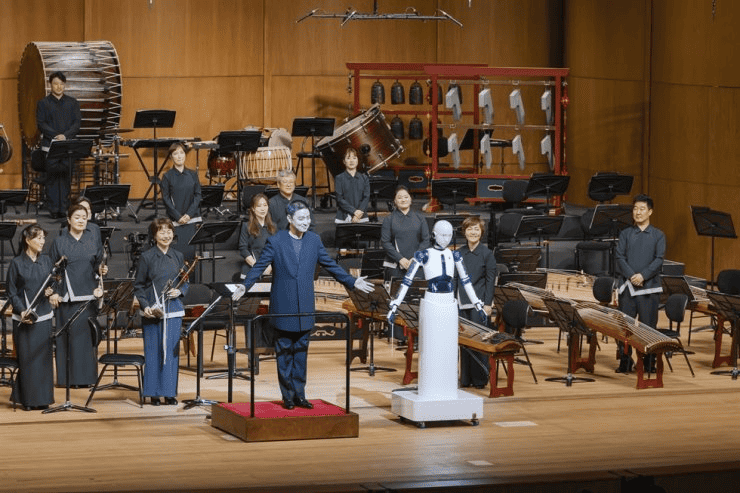
There are some jobs that robots just can’t take away from us, right? Surely, art is one of them, right?! Well, turns out that’s pretty debatable. In Seoul, South Korea, a robot called EveR 6 wowed the audience.
The unblinking maestro
Performing in front of a sold-out crowd, the robot put on a flawless performance, garnering a standing ovation. The 1.8 m tall robot guided an orchestra of 60 musicians playing classical Korean instruments, both solo and alongside a human conductor. There were no glitches and everything went smoothly, much to the delight of the audience.
“I think there will be more performances like this as technology progresses,” elementary school teacher Kim Yeon-joo said for Korea.net. “I look forward to seeing what technologies are added, what parts are supplemented and how detailed the next performance will be.”
Throughout the performance, EveR 6 stared at the orchestra, bobbing its head to the music and conducting smoothly and professionally. Barring the fact that it was unblinking, it almost seemed to behave like a human conductor. In a way, that’s exactly what it was doing.
EveR 6 uses motion-recognition technology and replicates what it learns from human musicians. It’s not really able to adapt on the spot — it was fortunate that everything went smoothly and there were no mistakes. If there had been, the robot had no way of adapting and improvising. So if you’re a worried conductor, the technology to overcome humans isn’t here just yet.
Even so, its performance was flawless.
“I was surprised to see EveR 6’s conducting movements. They were far more delicate than I expected,” human conductor Soo-Yeoul Choi on June 26 told a news conference.
Curiously, this wasn’t even the first robot conductor. That honor goes to the robot YuMi in Italy, who performed in 2017. YuMi led musicians, including renowned Italian tenor Andrea Bocelli — but it too followed the movements of a conductor
“The gestural nuances of a conductor have been fully reproduced at a level that was previously unthinkable to me,” maestro Andrea Colombini, whose movements were used to train the robot, said in a statement at the time. “YuMi achieves a very high level of fluidity of gesture, with an incredible softness of touch and expressive nuancing.”
But while the robotic conductors impress audiences and even professionals, they still need to be able to adapt to real-time changes. That’s exactly what EveR 6’s developers are currently working on. Lee Dong-Wook said he was happy that everything went according to plan — because if something went wrong, the researchers would have had to step in and address it.
“I was worried because the robot stopped two or three times at the lab, but I’m glad the performance ended with no mistakes. Though the probability of such an occurrence is extremely low, we had scenarios on how to respond if problems arose with EveR 6 during a real performance.”
Dong-wook is now working to make EveR 6 more intelligent. In particular, the robot aims to be able to make unprogrammed gestures and have a level of adaptability.
Even though EveR 6 isn’t even listening to the music and it’s just repeating a set of movements, its creators are happy that the robot provided a valuable service — and in one of humanity’s most artistic fields.
“It was rewarding in that it was a new attempt by a robot,” he added. “I feel good because this opportunity proved that a robot can provide not only service on behalf of people but also in culture and arts.”
This could prove to be a big challenge, but it could make robot conductors far more widespread and common.






